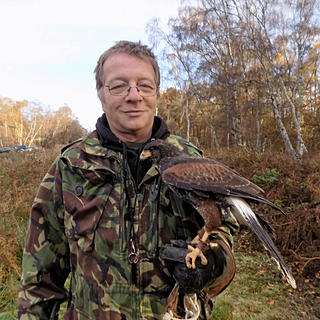WWII Falconry and The Peregrine
- Rupert Gladstone
- Mar 11, 2018
- 3 min read

All falconry practised for leisure purposes had to cease during the Second World War. Most falconers were called away for military service and either had to leave their birds behind or release them into the wild.

Huge areas of countryside traditionally used by falconers were sequestered for military use: barbed wire prevented access and legislation to protect allied carrier pigeons that where carried in boxes in Allied Planes to be released if they were shot down behind enemy lines all spelled danger for any free flying falcon in British skies. The Air Ministry ordered that the wild falcons on the South coast should be destroyed between 1904 -46, so around 600 were shot and many eggs and young were destroyed.

Early during World War II The airborne Carrier Pigeon threat to Britain was believed to be the pet project of SS chief Heinrich Himmler, who was known by British intelligence as an avowed pigeon fancier and Hitler appointed him President of the German National Pigeon Society.
Scores of lofts of the message-carrying birds were pinpointed by MI5 agents in 1940 across Belgium, West Holland and the Balkans.
One documented MI5 report on the phenomenon, released with a batch of wartime secret service documents, said: "From these prisoners of war it was learnt that it was anticipated that the birds would be used to convey information obtained by short-term pre-invasion agents."

According to documents now held at the Public Record Office in Kew, London, said at least two of the captured pigeons became "prisoners of war." Displaying humour in the midst of adversity, one intelligence officer marked in his report: "Both birds are now prisoners of war working hard at breeding English pigeons."
Agents had found that the Nazi party had taken control of all pigeon lofts in Germany after it assumed power, while Himmler had ordered the use of pigeons by his own Gestapo security police.
Intelligence officers also investigated ways in which pigeons were deposited in the UK. They believed some were carried in by individuals, and that some were dropped off in baskets by high-speed E-Boats and submarines.
Between 1941 and 1943 a top secret Falcon Squadron was recruited, trained and put in place to patrol the skies above the Scilly Isles near Keyhaven and all along the east coast as part of The New Army Pigeon Service, Special Section. The New Army Pigeon Service itself was our own answer to Carrier Pigeons, and during 1939-45 over 200,000 young pigeons were given to the services by the British pigeon breeders of the NPS a civilian organisation.The birds were used by the Royal Air Force and the Army and Intelligence Services, Special Section of the Army Pigeon Service (which was formed in World War I by Lt. Col. A.H.Osman).
During three and a half years of World War II, 16,554 war pigeons were parachuted onto the continent
The Special Section of the Army Pigeon Service did not have a pigeon to their name but instead they had Peregrine falcons trained to hunt pigeons.

Irish Falconer Ronald Stevens, in the above photograph, who some say was unquestionably the guru of the sport of Falconry in modern times, formed this unit and the idea was his. The idea had come to him because he had heard that in 1870 trained German falcons had been used to bring down French Pigeon Post during the siege of Paris.
Before the unit was formed Stevens had set to work with a friend and built a miniture range on it. He explained how a ring of falconers behind enemy lines could be used to stop German carrier pigeons. He sent photos of his models along with extensive logistical analyses to the Air Ministry. Stevens must have been excessively persuassive!
The MI5 report notes Britain's new anti-pigeon force would patrol for two hours at a time over the islands off the Cornish coast.
It also says: "This was a great success. The falcon flying high above the Scillies could watch not only a part of one island, but the whole group, and any pigeon flying over them would be attacked."
While researching this I also found a part transcription of World War II British Defence Regulations regarding the discovery of carrier pigeons and what they did with any messages they may have been carrying, that might interest you. This can be read by clicking the following link: https://www.arcre.com/pigeons/pigeonsdefregs













Comments